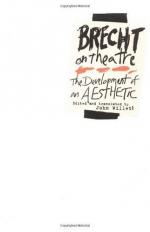|
This section contains 814 words (approx. 3 pages at 400 words per page) |

|
1933-1947 (Exile: Scandinavia, USA), Section 2 Summary and Analysis
On Gestic Music - This essay is more of an analysis/definition of the term "gest", which Brecht uses as a simile for emotional attitude. "A language is gestic", he writes, "when it ... conveys particular attitudes adopted by the speaker towards other men." Examples he offers suggest that in any communicative language, including music, the attitude is most effectively communicated before action.
The Popular and the Realistic - Brecht argues that realistic theatre as he defines it (true, uncluttered, unpretentious representations of what is) can and should be as popular as theatre that celebrates and indulges emotions. He describes how encountering and communicating with everyday workers convinced him that he was on the right track with his work, and argues that following the instincts for truth of those sorts of people will result...
(read more from the 1933-1947 (Exile: Scandinavia, USA), Section 2 Summary)
|
This section contains 814 words (approx. 3 pages at 400 words per page) |

|




